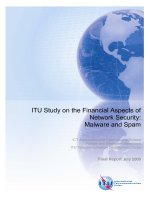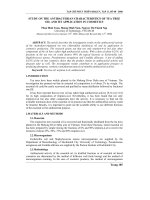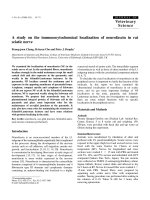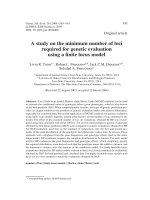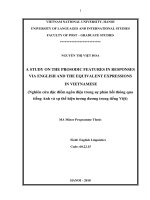A study on the immune status of children with wheezing and parasitic infection
Bạn đang xem bản rút gọn của tài liệu. Xem và tải ngay bản đầy đủ của tài liệu tại đây (229.59 KB, 7 trang )
Int.J.Curr.Microbiol.App.Sci (2018) 7(8): 4436-4442
International Journal of Current Microbiology and Applied Sciences
ISSN: 2319-7706 Volume 7 Number 08 (2018)
Journal homepage:
Original Research Article
/>
A Study on the Immune Status of Children with Wheezing
and Parasitic Infection
D. Joseph Pushpa Innocent1*, T. Sheila Doris Devamani1,
Margaret Theresa2 and Ajithkumar1
1
Department of Microbiology, 2Department of Pathology, Karpaga Vinayaga Institute of
Medical Sciences and Research Centre, Maduranthagam, Kanchipuram, India
*Corresponding author
ABSTRACT
Keywords
Wheezing children,
IgE antibody,
Allergy, Parasite
infection,
Entamoeba
histolytica
Article Info
Accepted:
26 July 2018
Available Online:
10 August 2018
The aim of this study was to identify the parasitic infection and the associated allergic
condition by studying the stool samples of the wheezing children and to correlate, the total
serum IgE antibody levels in those children. Further to study the type of parasites
commonly involved in these rural area. A total of 76 stool and blood samples were
collected from the wheezing children attended the allergy clinic at the Pediatric out patent
department of Karpaga Vinayaga Institute of Medical Science and Research Centre, during
a period of six months. Stool samples of children were examined microscopically for the
presence of ova/ cysts/ whole parasite and the body segments using saline and iodine wet
mount preparations. Serum samples were tested for total IgE antibodies by Turbidimetric
immunoassay. Results were analyzed, among the 76 stool samples examined from the
wheezing children, 48 are found to be positive contributing to a prevalence of 63.2 % of
intestinal parasitic infection in the study population. The most common intestinal parasite
was found to be Entamoeba histolytica (33.3%) followed by hook worm (27.1 %) and
Giardia intestinalis (23 %). Other less commonly detected parasites were cyst of E. coli in
5 cases (10.4%), ova of Ascaris lumbricoides (6.2%). A high prevalence of intestinal
parasites was observed in the wheezing children. Further the children with parasite
infection showed a higher level of total IgE in their serum.
Introduction
Literature survey showed that the wheezing in
children in a common respiratory symptoms
in allergic condition (Fernando, 2002). Poor
hygienic practice may cause parasite infection
among children. In rural area the periodical de
worming is not done regularly in childhood
(Luong, 2004). Parasite infection is one of the
triggering factors of wheezing in children
(Kunst et al., 2009). In allergic condition the
IgE antibody level will be increased
(Manohar et al., 2012). Immunity in secretary
regions are maintained by IgA class of
antibodies (Harry W. Schroeder et al., 2010).
When the IgA level in those regions
decreased by any chance, then the microbes
may invade the areas such as respiratory and
intestinal mucosa (Nicholas J. Mantis et al.,
2013). In such conditions the foreign antigens
4436
Int.J.Curr.Microbiol.App.Sci (2018) 7(8): 4436-4442
may induce the allergic response of the host
(Norman et al., 1998). Ultimately the IgE
antibodies were induced and increased
(Thomas, 2001). Therefore it is a fact that IgA
and IgE titers are inversely proportional
(Michael et al., 2010). In some cases there
will be an infection, but there was no
induction of antibody against the infection,
infers the immunodeficiency of the individual
(Andrea Lantz et al., 2001). Hence this study
was planned to analyze the immune status of
the children showed the signs and symptoms
of allergy and to rule out the role of parasitic
infection and the associated IgE level in such
conditions.
Worldwide about 3.5billion of population is
infected with intestinal parasites, which
include mostly children (WHO, 1998). As
reported by World Health Organization
(WHO) more than 1.5 billion people are
infected with contaminated soil (Blouin et al.,
2018).These infections are distributed in
tropical and subtropical areas, with the
majority occurring in developing countries.
The warm and moist climate of tropical and
subtropical countries provides the ideal
environment for the survival of parasite eggs
or larvae of these four soil transmitted
helminth (STH), roundworm (Ascaris
lumbricoides),
whipworm
(Trichuris
trichiura)
and
hookworm
(Necator
americanus,
Ancylostoma
duodenale)
(Brooker et al., 2006).. It is mentioned that
approximately 270 million children in the
preschool-age and nearly 600 million in
school-age are living in areas associated with
intensive transmission of intestinal parasites
(WHO, 2014). There by necessitating
treatment and prevention.
In India the prevalence rates greatly varies
due to environmental, climatic and socioeconomic conditions. Various studies reported
on the prevalence of parasitic infection are as
follows 49 % in East Godavari of Andhra
Pradesh (Padmaja et al., 2015), 75.28 % in
Kashmir (Wani et al., 2007), 51.5 % in
Karnataka (Shubha et al., 2011) and 26.88 %
in East Delhi (Mahajan et al., 1993). Among
the
protozoan
parasites,
Entamoeba
histolytica, Giardia intestinalis and coccidian
parasites are common in children. Whereas
the most common helminthes detected in
children is Ascaris lumbricoides and it is the
common parasite found in India followed by
Hookworm, Hymenolepis nana, Tapeworm,
Trichuris trichiura, Enterobius vermicularis,
Entamoeba histolytica, Entamoeba coli and
Giardia lamblia (Virk et al., 1994).
Several socio-economic, personal and
environmental factors like poverty, illiteracy,
lack of safe water for drinking, overcrowding,
poor personal hygiene, lack of toilet facilities
and several other factors are associated with
occurrence of intestinal parasitic infection in
children (Padmaja et al., 2014; Mane et al.,
2014).
Materials and Methods
Seventy six stool samples were collected from
children from the age group of 3 to 13 years,
showing signs and symptoms of wheezing
who attended the children OPD for treatment
at Karpaga Vinayaga Institute of Medical
science
and
Research
Centre,
Cinnakolambkkam for a period of six months
between March 2017 and August 2017.
The study was explained to the parents of the
child before collect their personal, medical
history and specimens. Further this study was
approved by the Institute Ethical Committee.
Stool samples were collected in a clean and
wide mouth container without contaminating
urine. Similarly 2 mL of blood samples were
also collected aseptically in a sterile vial from
those children and allowed for 20 minutes at
room temperature for clot formation. After
retraction of the clot the vials are centrifuged
4437
Int.J.Curr.Microbiol.App.Sci (2018) 7(8): 4436-4442
at 2500 RPM for 20 minutes. The clear sera
were collected in a vial and labeled. Stool and
the serum samples were transported
immediately to the Microbiology department.
The cross sectional study was carried out in
the department of Microbiology.
Identification of parasites in stool
Macroscopic examination
Macroscopic examination of stool includes
the observation of odour, consistency, color
and presence of blood, mucus or segments of
adult worms. Liquid specimens are examined
within 30 minutes for trophozoite detection
and semisolid specimens within 60 minutes.
Preservatives like formalin, polyvinyl alcohol
(PVA) were used whenever preservation is
needed.
Microscopic examination
Freshly passed stool specimens were collected
in clean dry container and are examined
immediately. Stool sample were examined
microscopically for the presence of ova/
cysts/ whole parasite and the body segments
in wet mount preparations with 0.9% saline
and Dobell’s iodine. Saline mount for the
visualization of bile staining property of eggs,
live motile larvae or trophoziotes and the
iodine mount for the in better visualization of
finer objects like nuclei. In certain conditions
like enterobiasis, peri-anal swab using NIH
swab or Scotch cellulose adhesive tape were
used. The parasites were identified by their
specific morphology of ova/cyst etc.
Estimation of total IgE
The serum samples of the children were tested
for the presence of IgE antibodies by
Turbidimetric immunoassay using Quantia–
IgE kit. A Calibrator curve was constructed
using with the given known concentration of
calibrator and its different concentrations
prepared by serial dilution with saline.
Spectrophotometer was adjusted to read zero
with saline at 630nm wave length. As per the
procedure of the kit the activation buffer and
the Quantia IgE reagents were mixed and
incubated in a curette for 5 mints at 37◦C, and
added the calibrator mixed well and
incubated. Absorbance values were measured
at the end of 10 seconds (A1) and again at the
end of 4 minutes (A2). A2-A1 gives the
absorbance value (A) of that concentration.
The same procedure was repeated with the
other serially diluted calibrators and their
absorbance values were noted using the
Instrument and the values were calculated. A
graph was plotted on the absorbance versus
the concentration of the calibrators. The same
procedure was repeated for each of the serum
samples collected from the children and the
absorbance values were measured. Making
use of the calibrator curve the Total IgE
values were calculated for each of the serum
sample collected.
Results and Discussion
Characteristics of study population
A total of 76 wheezing children were included
in this study, of which 42 were boy children
(55.3%) and 34were girls (44.7%) among the
42 boys 27were showed positive reports
(64.3%) whereas among the 34 girls 21
showed positive (61.8%) for parasites.
Majority of children were in the age group of
6-10 years 42 (47.4%) followed by children
of age group less than 5 years of age
contributed 28 (36.8%). The age group
between
11≥13
years
only
12
(15.8%).Presence of parasites in various age
groups were as follows among the group 3≤5
years 24 (50%), in group 6-10 years 22
(45.8%) and in group 11≥13 years of age only
2 (4.2%) were positive for parasitic infection
(Table 1).
4438
Int.J.Curr.Microbiol.App.Sci (2018) 7(8): 4436-4442
Prevalence of intestinal parasitic infections
Among the 76 stool samples examined from
the wheezing children,48 were found to be
positive contributing to a prevalence of 63.2
% of intestinal parasitic infection in the study
population. The most common intestinal
parasite was found to be Entamoeba
histolytica (33.3%) followed by hook worm
(27.1 %) and Giardia intestinalis (23 %).
Other less commonly detected parasites were
cyst of E.coli in 5 cases (10.4%), ova of
Ascaris lumbricoides (6.2%). Shown in table
2.
It was observed that the cyst of Entamoeba
histolytica and the eggs of Hookworm are the
most commonly present parasites in our study
population.
Table.1 Distribution of intestinal parasite in stool samples
Factors
N=76
Parasite
+ve =48
(63.2%)
Age
3≤5
6-10
11≥13
Sex
Boys
Girls
Monthly income
≤5000
5001-10000
10001-20000
>20000
-- ve =28
(36.8%)
28 (36.8%)
36 (47.4%)
12 (15.8%)
24(50.0%) 04(14.3%)
22(45.8%) 14(50.0%)
02(04.2%) 10(35.7%)
42 (55.3%)
34 (44.7%)
27(64.3%) 15(35.7%)
21(61.8%) 13(38.2%)
13 (17.1%)
43 (56.6%)
11 (14.5%)
09 (11.8%)
11(22.9%)
31(64.6%)
05(10.4%)
01 (2.1%)
02(07.1%)
12(42.9%)
06(21.4%)
08(28.6%)
Table.2 Prevalence of Intestinal parasites
Sl.no
Parasite
Number of
Samples (48)
(%)
1
Entamoeba histolytica
16
33.3%
2
Entamoeba coli
05
10.4%
3
Hookworm egg
13
27.1%
4
Ascaris lambricoides
03
06.2%
5
Giardia intestinalis
11
23.0%
4439
Int.J.Curr.Microbiol.App.Sci (2018) 7(8): 4436-4442
Table.3 Total serum IgE antibody levels in various groups of children
CATEGORY OF
CHILDREN
WITH WHEEZE
WITH PARASITE
INFECTED
HEALTHY CONTROLS
No studied
IgE level
(mean±SE IU/mL)
P valve
76
48
1194.2±169.4
1527.0±176
P <0.001
P<0.001
10
160.4± 57.16
P<0.001
The total serum IgE antibody levels in
children
Among the 76 children aged between 3 and
13 years with signs and symptoms of wheeze
when tested for the total IgE level using
Turbidimetric immunoassay a mean IgE level
of 1194.2±169.4 IU/mL was observed.
Whereas the total level of Ig E of the parasite
infected 48 children showed a mean Ig E level
of 1527±176IU/mL. When we tested a control
group of 10 healthy children with non
wheezing and parasitic infection showed a
mean Ig E level of only 160.4±57.16 IU/mL
(p<0.001) (Table 3).
Detection of the immune status of the
wheezing children infected with parasites
were studied by serum IgE and the levels of
each of the children were analyzed and were
compared and correlated with the reports of
the stool sample studies.
Increasing prevalence of wheezing is one of
the common chronic disorders of the children
It has been associated with increased
exposure
to
environmental
allergens.
Literature survey revealed that the bacteria
and virus may also cause exacerbation of
asthmatic wheezing. The present study was
planned to understand the parasitic infection
and its role in causing asthmatic wheezing in
children. The results showed a lot of parasites
infect the gastro intestinal tract in children.
Reports suggested the invasive larvae during
its migration through the lungs induce a
strong eosinophil rich inflammation in the
lungs. Intestinal helminthes infection may
also
capable
of enhancing allergic
inflammation (Van den Bigelaar et al., 2000).
The study report explained the association of
the parasites and its capability of enhancing
allergic inflammation. Yet another study it
was stated that A. lumbricoides was
associated with increased risk of Asthma
(Leonardi-Bee et al., 2006). In the present
study stool samples were collected from the
children who were suffered from asthmatic
wheeze. Presence of ova of Ascaris
lumbricoides and some other parasites in the
samples of affected children correlate with
other studies. Allergy is IgE mediated type I
hypersensitivity (Mathias 2011).. In normal
condition the serum IgE is present in trace
amounts. Usually the total IgE level increases
with amount of exposure to relevant allergens
(Gruchalla et al., 2005). Measurement of
serum IgE is useful to determine if the
allergic reaction is IgE mediated and its level
increases in parasitic infection (Bell, et al.,
1996). Various study report indicated a
significant fall in IgE concentration after
effective therapy. Present study reports
conclude that a number of wheezing children
showed ova and cysts in their stool samples
indicating the parasitic infection. Wheezing
children with parasite infection showed a
higher level of total IgE in their serum. This
base line data may be fine-tuned by further
investigations with more number of cases and
allergen specific IgE antibody tests.
4440
Int.J.Curr.Microbiol.App.Sci (2018) 7(8): 4436-4442
Acknowledgement
Authors acknowledge the Managing director
KIMS for the financial support for this project
and for the constant encouragement. The
author is also grateful to authors/ editors/
publishers of all those articles, journals and
books from where the literature for this
manuscript has been reviewed and discussed.
References
Van den Bigelaar AHJ, Van Ree R,
Rodrigues LC, Lell B, Deelder
AM,Kremsner PG, Yazdanbakhsh M.
(2000). Decreased atopy in children
infected with Schistosoma hematobium:
Arole of parasite inducedinterleukin-10.
Lancet. 356:1723-7.
.Mane M, Kadu A, Mumbre S, Deshpande M,
Gangurde N. 2014. Prevalence of
intestinal parasitic infections and
associated risk factors among preschool children in tribal villages of
North Maharashtra, India. Int J Res
Health Sci; 2(1):133-9
Andrea Lantz MD. Jack Armstrong MD
Bettywray MD.2001.Immunoglobulin
deficiency in children with a sudden
overwhelming infection. Annals of
allergy, asthma and immunology. vol.
86(1): 55-58.
Bell, RG., JA Baker., (1996).Institute for
Animal Health, IgE, allergies and
helminth parasites: A new perspective
on an old conundrum Immunology and
Cell Biology volume74, pages337–345
Blouin B, Casapía M, Joseph L, Kaufman JS,
Larson C, Gyorkos TW. 2018. The
effect of cumulative soil-transmitted
helminth infections over time on child
development: a 4-year longitudinal
cohort study in preschool children using
Bayesian methods to adjust for
exposure misclassification. Int J
Epidemiol. 2018 Jul 12. doi:
4441
10.1093/ije/dyy142. [Epub ahead of
print]
Brooker S, Clements AC, Bundy, DA., 2006.
Global epidemiology, ecology and
control of soil-transmitted helminth
infections. Adv Parasitol.;62: 221–61
Gruchalla RS, Pongracic J, Plaut M, Evans
R, 3rd, Visness CM, Walter M., 2005
Inner City Asthma Study: relationships
among sensitivity, allergen exposure,
and asthma morbidity. J Allergy Clin
Immunol.; 115: 478–485. [PubMed]
Harry W Schroeder, Jr., Lisa Cavacini. 2010.
Structure
and
Function
of
Immunoglobulins. Volume 125, Issue 2,
Supplement 2, S1-S394 Edited by
William T. Shearer, Donald Y.M.
Leung.
Kunst, H., D Mack, O M Kon, AK Banerjee,
P Chiodini, A Grant. 2009. Parasite
infections of the lung: A guide for the
respiratory
physician.
Thorax
66(6):528-36 · September 2010 with
325 Reads DOI: 10.1136/thx.2009.
132217.
Leonardi-Bee J, Pritchard D, Britton., (2006).
J. Asthma and current intestinal parasite
infection: systematic review and metaanalysis. Am J Respir Crit Care Med
174:514–2310.1164/rccm.200603331OC[PubMed]
Luong, TV., 2004. De worming school
children and hygiene intervention.
Pages S153-159. Published online 06
Aug 2010.
Mahajan M, Mathur M, Talwar V, Revathi G.
1993. Prevalence of intestinal parasitic
infections in East Delhi. Indian J
Community Med; 111: 177-9
Manohar,S.,
R.Selvakumaran,
2012.
European Journal of Experimental
Biology 2 (6):2199-2205
Mathias, C. B. et al. (2011). IgE-mediated
systemic anaphylaxis and impaired
tolerance to food antigens in mice with
enhanced I-4 receptor signaling. J
Int.J.Curr.Microbiol.App.Sci (2018) 7(8): 4436-4442
Allergy Clin. Immun. 127, 1–6
Matinez,D., 2002. Development of wheezing
disorders and asthma in preschool
children. vol- 109/ issue From the
American Academy of Pediatrics.
Michael E. Possin, Stephanie Morgan, and
James, E., 2010. The relationships
among Ig levels, Allergic Sensitization.
Gern Pediatr allergy immunol; Sep: 21
(6): 990-996
Nicholas J. Mantis., Nicolas Rol., Blaise
Corthésy, (2011). Secretory IgA's
complex roles in immunity and mucosal
homeostasis in the gut. Mucosal
Immunology volume4, pages 603–611.
Norman H. Edelman., Edelman, M.D.
1998.The American Lung Association
Asthma advisory group, Family Guide
to asthma and Allergies: How you and
your children can breath Easier, Boston:
Litte Brown. Padmaja, Swaroop S.
Nageswararao P. 2014. Prevalence of
Intestinal Parasitic Infections among
School Children in and around
Amalapuram. J Pub Health Med
Res;2(2):36-8.
Platts-mills,E., A,Thomas., 2001.The role of
Ig E in allergy and asthma
/>/ajrccm.164.
supplement_1.2103024
PubMed:
11704610
Shubha, DS., Fatima, F., 2007. A
coprological survey for assessing
intensity of parasitic infection in school
children: Crosssectional study. Trop
Parasitol 2011;1:88-93.
Virk KJ, Prasad RN, Prasad H. 1994.
Prevalence of intestinal parasites in
rural areas of district Shahjahanpur,
Uttar Pradesh. J Commun Dis; 26(2):
103-8[PubMed]
Wani SA, Ahmad F, Zargar SA, Ahmad Z,
Ahmad P, Tak H.,2007. Prevalence of
intestinal parasites and associated risk
factors among schoolchildren in
Srinagar
City,
Kashmir,
India.J
Parasitol; 93(6):1541-3.
WHO (2014). Fact sheet no 366. Available
online
athttp;//www.who.int/worm
control. Accessed June 25, 2014.
WHO(1998). Control of Tropical Diseases.
Kashmir,
India
World
Health
Organization, Geneva [Ref list]
How to cite this article:
Joseph Pushpa Innocent, D., T. Sheila Doris Devamani, Margaret Theresa and Ajithkumar.
2018. A Study on the Immune Status of Children with Wheezing and Parasitic Infection.
Int.J.Curr.Microbiol.App.Sci. 7(08): 4436-4442. doi: />
4442


